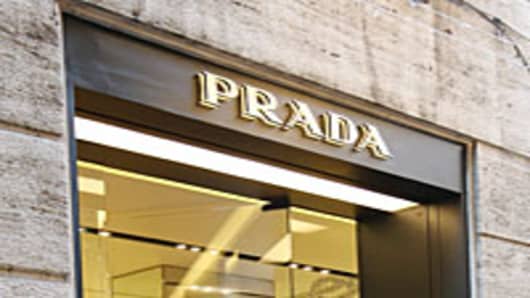Italian fashion house Prada has been a bright spot in a slowing global luxury retail space, and its latest earnings report underscores the resilience.
The company delivered another set of solid earnings on Tuesday — first-half net profit surged 60 percent to 286 million euros ($372 milion), thanks to demand from Asian spenders. Its Hong Kong-listed shares are up 70 percent so far this year, outperforming the S&P Global Luxury Index which is up around 17 percent in the same period.
But analysts are warning of a sharp pullback in its earnings growth in the second half, as Prada, which has managed to buck the sector’s decline because of its low penetration in key luxury markets, succumbs to a global demand slowdown.
"Prada has held up remarkably well because of its retail under-penetration, delivering upside surprises in the last three quarters. However, as the industry headwinds intensify, we think it will likely start being affected as well," Gloria Tsuen, retail analyst at CIMB said.
Global luxury stocks have come under some pressure in the recent weeks after Burberry issued a profit warning earlier this month, warning that its full year profits would come in at the lower-end of market expectations due to a slowdown in global sales.
The U.K. brand, known for its signature plaid pattern, says growth in China was starting to moderate as consumers remained cautious ahead of the pending political leadership transition and reduced gift giving.
Tsuen believes Prada will eventually go the way of Burberry. She expects its quarterly earnings growth to slow to the mid-teens in July-December period, and has downgraded her outlook on the stock from overweight to neutral earlier this month.
Trading at 27 times 2012 earnings, the stock is vulnerable to a selloff after its strong 70 percent year-to-date run, she said.
Francis Lun, managing director at Lycean Securities, agrees that Prada is not shielded from the overall pullback in luxury spending.
"In Hong Kong you’ll notice that the lines outside stores like Prada aren’t as long as last year. The number of consumers buying these products is actually starting to shrink. After everyone has bought a Prada it’s no longer a novelty," he said.
Lun believes the stock, which is trading near HK$60 is close to being fully valued, adding that investors looking to gain exposure to the stock should hold off until it falls to HK$55.
Prada & Burberry: Different Dynamics
Juan Manuel Mendoza, head of Asian equities at Credit Suisse's Asset Management Division, however, argues that Prada will not undergo a dramatic slump in sales growth like Burberry, as its product mix is more favorable in comparison.
Burberry derives the majority of its sales from its apparel business, which is more sensitive to the slowdown in spending, while Prada generates half of its sales from its leather goods products – which offer higher margins than apparel and enjoy more resilient demand, he explained.
According to historical trends, customers are more likely to postpone a purchase in apparel or jewelry than a leather bag, he added.
Mendoza projects Prada’s same store sales growth will fall to the low teens, from 19 percent in the first-half.



